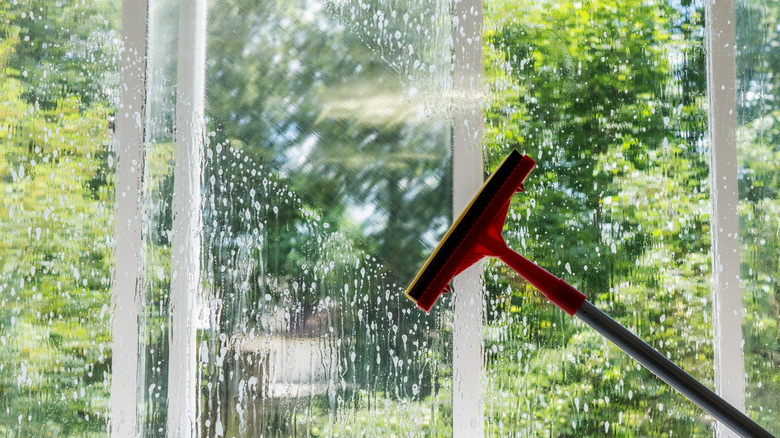October Is The Perfect Time To Wash Your Windows - Here's How To Do It
We may receive a commission on purchases made from links.
Spring cleaning often gets all the glory, but when it comes to washing your windows, pollen and rain can quickly undo all your hard work in a matter of weeks. Blazing summer heat and bone-chilling winter temperatures both make the tedious task downright miserable. But fall is ideal when it comes to outdoor chores, like swapping out screens for storm windows, pressure-washing your patio pavers, cleaning your gutters, and yes, washing your windows. And October is the perfect time because there's still enough sun to make streaks visible, but temperatures are cooling off, so your cleaner won't dry too fast or leave stubborn residue behind.
Sparkling windows will let you actually enjoy the view of your garden, trick-or-treaters, and that first snowfall. It's a good idea to tackle this task before hanging wreaths, stringing fairy lights, or perfectly positioning your holiday lawn inflatables. Nothing's scarier than spending an afternoon washing windows only to discover streaks or a faint coating of the wrong cleaner left behind, so you'll want to start by gathering the right tools and supplies to get the job done perfectly. You'll need a tool like the DSV Standard Window Squeegee, soft microfiber cloths, a bucket, and a telescoping pole to help you reach your highest windows. You'll also want to use a totally streak-free cleaner. There are plenty of popular glass sprays out there, but for really grimy windows, it's hard to beat a simple mix of warm water with a squirt of dish soap. Lastly, protect your hands with a good pair of rubber gloves, and keep a few old towels or a drip cloth nearby for wiping cruddy windowsills.
Step-by-step guide to washing your windows
Washing your windows is a straightforward process, but for the best results, you'll need to do a little prep work first. Start by cleaning each window track — the grooved channel sitting inside the windowsill that accumulates dirt, debris, allergens, and even bugs over time. A handled brush or handheld vacuum is the best way to clean window tracks. If you're taking your screens out, do that first so you can clean as much of the track as possible. This is also a good time to examine both your windows and screens for any weatherproofing or repairs they need.
Next, use a clean microfiber cloth to wipe any dust, cobwebs, or other debris from the glass. If it's been a while since you washed your windows and there are large marks or smudges, apply a little cornstarch or another nonabrasive cleaner with your microfiber cloth to spot-clean them. If your window squeegee has a microfiber scrubber attached, you'll then dip this into your bucket full of warm water and dish soap before working your way from the top to the bottom of each pane of glass in a circular motion. This will loosen grime, so make sure to rinse your scrubber frequently. Finally, use the squeegee itself to remove any excess water, pulling it firmly across the window. Wipe the squeegee blade clean after each pass, and overlap your strokes slightly to prevent lines. Use your telescoping pole for hard-to-reach windows. Finally, do any detailed cleaning in corners and around missed edges with a clean microfiber cloth. You should then thoroughly dry the sill and frame to prevent any water damage.

